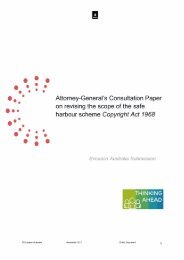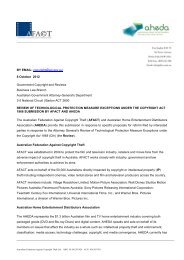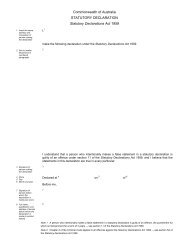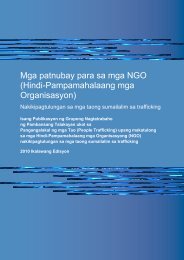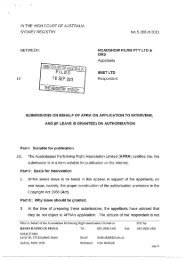Normann Witzleb [PDF 657KB] - Attorney-General's Department
Normann Witzleb [PDF 657KB] - Attorney-General's Department
Normann Witzleb [PDF 657KB] - Attorney-General's Department
Create successful ePaper yourself
Turn your PDF publications into a flip-book with our unique Google optimized e-Paper software.
wrongful harm to a recognised legal interest, such as bodily integrity, 89 reputation, or,<br />
potentially, privacy. It is therefore a little misleading to suggest that the false light tort is<br />
concerned with protecting reputation, rather than freedom from emotional distress.<br />
Indeed, the false light tort protects the plaintiff where a publication is untrue but not<br />
damaging to the plaintiff’s reputation. It thus fills a gap left by the law of defamation.<br />
Rather than protecting reputation, it protects the plaintiff’s interest in not having<br />
untruths published about them. This is an interest properly falling within the domain of a<br />
privacy action. A false light tort is therefore also unlikely to undermine the distinction<br />
between privacy and defamation.<br />
52 In light of the ongoing debate on the appropriate scope of privacy protection, it is<br />
appropriate to formulate the cause of action broadly and leave its further development<br />
to the courts. Statutory law reform in the area of privacy is notoriously difficult to<br />
achieve. This makes it imperative to make the law ‘future-proof’ and to enable new<br />
forms of privacy infringement to be accommodated, if and when they arise. While the<br />
recommendation of the VLRC has clarity on its side, it closes the door to future<br />
development of the law. This makes the more open-textured proposals of the ALRC and<br />
the NSWLRC preferable. Even though the two proposals are likewise not intended to<br />
address the full range of potential privacy invasions, they at least do not rule out that<br />
other privacy wrongs may become actionable under the statutory tort.<br />
53 Notwithstanding the fact that information privacy and intrusion into seclusion are the<br />
areas that are likely to be dominant in practice, the cause of action should not exclude<br />
cases in which a plaintiff is placed into a false light. This is important not least for<br />
practical reasons because the various phenomena of privacy invasions will often<br />
overlap in practice. McKennitt v Ash 90 was a case of breach of confidence, in which Ms<br />
Ash made allegations about the private life of Ms Kennitt, a renowned folk musician,<br />
which were both invasive and untrue. Ms Ash had been a close friend of Ms Kennitt.<br />
When the friendship ended acrimoniously, Ms Ash published a book that detailed Ms<br />
Kennitt’s personal and sexual relationships, including her feelings after the death of her<br />
fiancé, her health and diet and much other personal and private information. The book<br />
also contained Ms Ash’s account of a property dispute that had arisen between the<br />
parties. At trial, Ms Ash sought to justify publicising this dispute with the public interest<br />
in revealing Ms Kennitt’s true character as a vindictive person. The trial judge found,<br />
however, that most of Ms Ash’s allegations concerning the dispute were untrue and that<br />
their publication was therefore not in the public interest. Ms Ash then sought to seize on<br />
this finding of falsity and argued that Ms Kennitt could not have a reasonable<br />
expectation of privacy in relation to false statements. The Court of Appeal rejected this<br />
argument. Longmore L.J. stated:<br />
The question in a case of misuse of private information is whether the<br />
information is private, not whether it is true or false. The truth or falsity is an<br />
89 This includes negligence (damages for pain and suffering, loss of amenities) as well as assault and<br />
battery (general damages).<br />
90 McKennitt v Ash [2008] QB 73; [2006] EWCA Civ 1714.<br />
19


![Normann Witzleb [PDF 657KB] - Attorney-General's Department](https://img.yumpu.com/26247895/19/500x640/normann-witzleb-pdf-657kb-attorney-generals-department.jpg)


